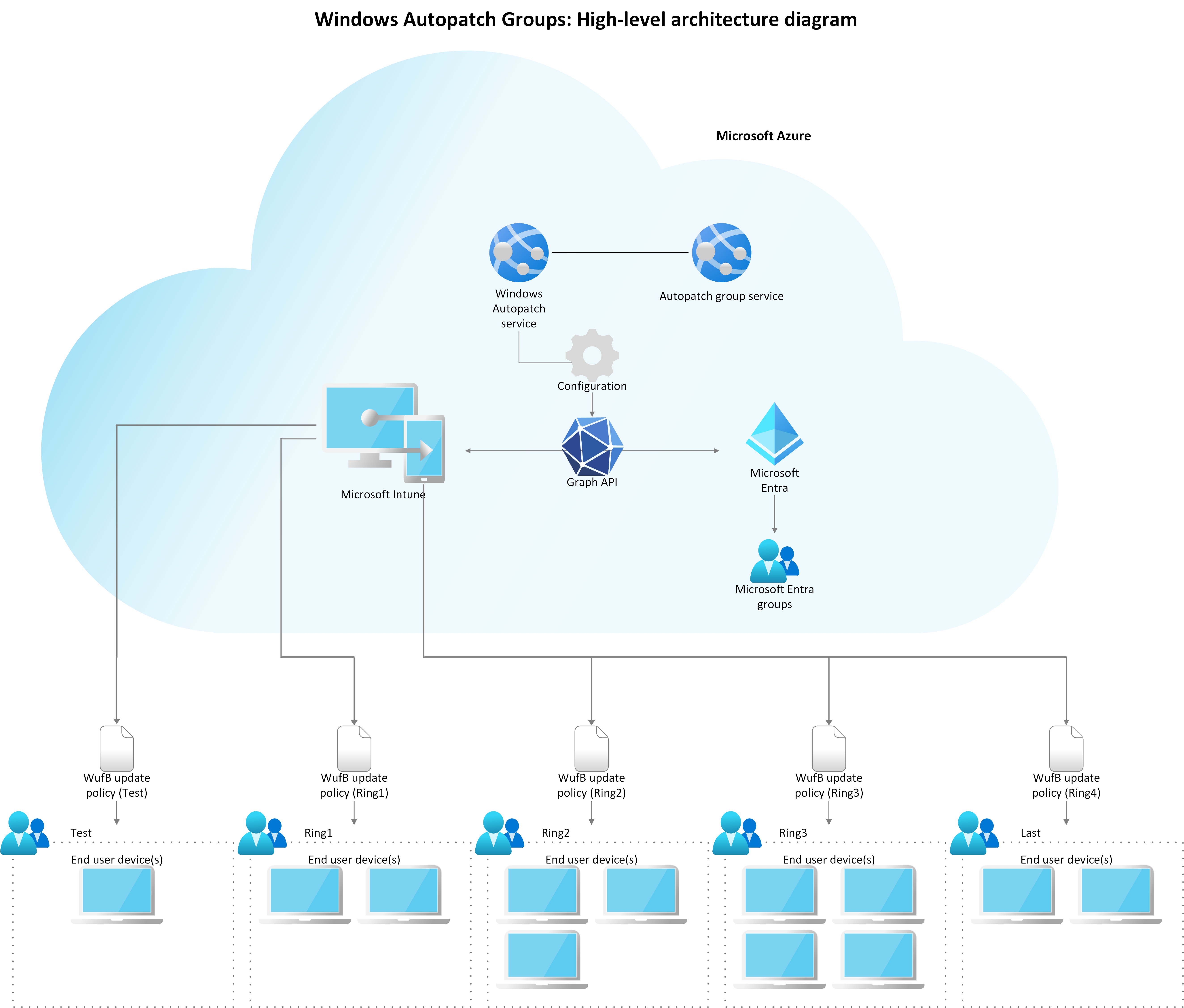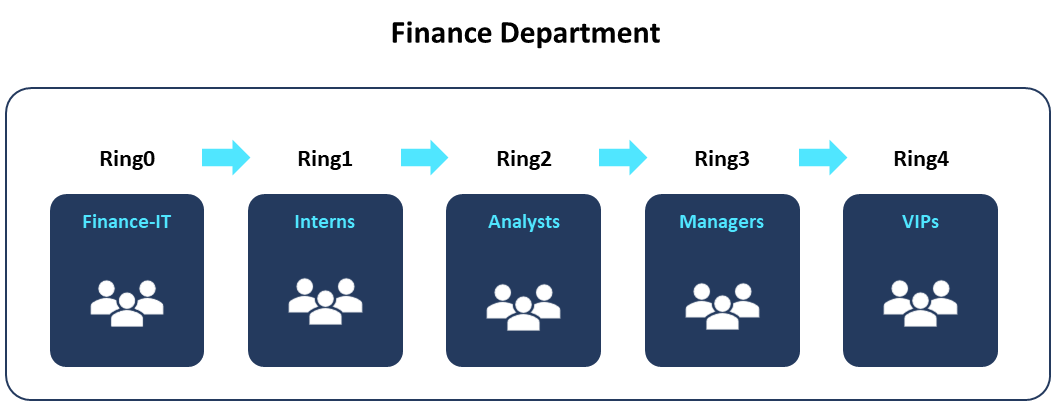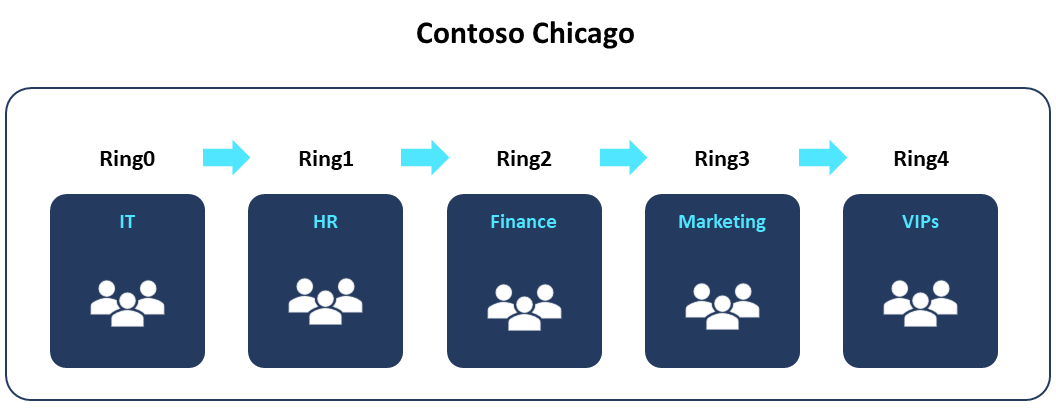Windows Autopatch groups
Important
The information in this article or section only applies if you have Windows Enterprise E3+ or F3 licenses (included in Microsoft 365 F3, E3, or E5) licenses and have activated Windows Autopatch features.
Feature activation is optional and at no additional cost to you if you have Windows 10/11 Enterprise E3 or E5 (included in Microsoft 365 F3, E3, or E5) licenses.
For more information, see Licenses and entitlements. If you choose not to go through feature activation, you can still use the Windows Autopatch service for the features included in Business premium and A3+ licenses.
As organizations move to a managed-service model where Microsoft manages update processes on their behalf, they’re challenged with having the right representation of their organizational structures followed by their own deployment cadence. Windows Autopatch groups help organizations manage updates in a way that makes sense for their businesses with no extra cost or unplanned disruptions.
What are Windows Autopatch groups?
An Autopatch group is a logical container or unit that groups several Microsoft Entra groups, and software update policies, such as Update rings policy for Windows 10 and later and feature updates for Windows 10 and later policies.
Autopatch groups are intended to help organizations that require a more precise representation of their organization's structures along with their own update deployment cadence in the service.
By default, an Autopatch group has the Test and Last deployment rings automatically present. For more information, see Test and Last deployment rings.
Key benefits
Autopatch groups help Microsoft Cloud-Managed services meet organizations where they are in their update management journey. Key benefits include:
| Benefit | Description |
|---|---|
| Replicating your organizational structure | You can set up Autopatch groups to replicate your organizational structures represented by your existing device-based Microsoft Entra group targeting logic. |
| Having a flexible number of deployments | Autopatch groups give you the flexibility of having the right number of deployment rings that work within your organization. You can set up to 15 deployment rings per Autopatch group. |
| Deciding which devices belong to deployment rings | Along with using your existing device-based Microsoft Entra groups and choosing the number of deployment rings, you can also decide which devices belong to deployment rings during the device distribution process when setting up Autopatch groups. |
| Choosing the deployment cadence | You choose the right software update deployment cadence for your business. |
Prerequisites
Before you start managing Autopatch groups, ensure you meet the following prerequisites:
| Prerequisite | Details |
|---|---|
| Review Windows Autopatch groups overview documentation | Understand key benefits and common ways to use Autopatch groups within your organization. |
| Make sure you have app-only auth turned on in your Windows Autopatch tenant. Otherwise, the Autopatch groups functionality doesn't work properly. Autopatch uses app-only auth to: |
|
| Make sure that all device-based Microsoft Entra groups you intend to use with Autopatch groups are created before using the feature. | Review your existing Microsoft Entra group dynamic queries and direct device memberships to:
|
| Ensure devices used with your existing Microsoft Entra groups meet device registration prerequisite checks when being registered with the service | Autopatch groups register devices on your behalf, and device readiness states are determined based on the registration state and if any applicable alerts are targeting the device. For more information, see the Devices report. |
Tip
Update rings and feature updates for Windows 10 and later policies that are created and managed by Windows Autopatch can be restored using the Policy health feature. For more information on remediation actions, see restore Windows update policies.
Register devices into Autopatch groups
Autopatch groups register devices with the Windows Autopatch service when you either create or edit an Autopatch group. For more information, see Register devices into Autopatch groups.
High-level architecture diagram overview
An Autopatch group is a function app that is part of the device registration micro service within the Windows Autopatch service. The following table explains the high-level workflow:
| Step | Description |
|---|---|
| Step 1: Create an Autopatch group | Create an Autopatch group. Autopatch groups register devices with the Windows Autopatch service when you either create or edit an Autopatch group. |
| Step 2: Windows Autopatch uses Microsoft Graph to create Microsoft Entra ID and policy assignments | Windows Autopatch service uses Microsoft Graph to coordinate the creation of:
|
| Step 3: Intune assigns software update policies | Once Microsoft Entra groups are created in the Microsoft Entra service, Intune is used to assign the software update policies to these groups and provide the number of devices that need the software update policies to the Windows Update for Business (WUfB) service. |
| Step 4: Windows Update for Business responsibilities | Windows Update for Business (WUfB) is the service responsible for:
|
Autopatch group deployment rings
Deployment rings make it possible for an Autopatch group to have software update deployments sequentially delivered in a gradual rollout within the Autopatch group.
Windows Autopatch aligns with Microsoft Entra ID and Intune terminology for device group management. There are two types of deployment ring group distribution in Autopatch groups:
| Deployment ring distribution | Description |
|---|---|
| Dynamic | You can use one or more device-based Microsoft Entra groups, either dynamic query-based or assigned to use in your deployment ring composition. Microsoft Entra groups that are used with the Dynamic distribution type can be used to distribute devices across several deployment rings based on percentage values that can be customized. |
| Assigned | You can use one single device-based Microsoft Entra group, either dynamic query-based, or assigned to use in your deployment ring composition. |
| Combination of Dynamic and Assigned | To provide a greater level of flexibility when working on deployment ring compositions, you can combine both device distribution types in Autopatch groups. The combination of Dynamic and Assigned device distribution is not supported for the Test and Last deployment ring in Autopatch groups. |
Test and Last deployment rings
Both the Test and Last deployment rings are default deployment rings that are automatically present in an Autopatch group. These default deployment rings provide the recommended minimum number of deployment rings that an Autopatch group should have.
If you don't add more deployment rings when creating an Autopatch group, the Test deployment ring can be used as the pilot deployment ring and Last can be used as the production deployment ring.
Important
Both the Test and Last deployment rings can't be removed or renamed from Autopatch groups. Autopatch groups don't support the use of one single deployment ring as part of its deployment ring composition because you need at least two deployment rings for their gradual rollout. If you must implement a specific scenario with a single deployment ring, and gradual rollout isn't required, consider managing these devices outside Autopatch groups.
Tip
Both the Test and Last deployment rings only support one single Microsoft Entra group assignment at a time. If you need to assign more than one Microsoft Entra group, you can nest the other Microsoft Entra groups under the ones you plan to use with the Test and Last deployment rings. Only one level of Microsoft Entra group nesting is supported.
Common ways to use Autopatch groups
The following are three common uses for using Autopatch groups.
Use case #1
| Scenario | Solution |
|---|---|
| You're working as the IT admin at Contoso Ltd. Your organization needs to plan a gradual rollout of software updates within specific critical business units or departments to help mitigate the risk of end-user disruption. | You can create an Autopatch group for each of your business units. For example, you can create an Autopatch group for the finance department and breakdown the deployment ring composition per the different user personas or based on how critical certain user groups can be for the department and then for the business. The following is a visual representation of a gradual rollout for Contoso’s Finance department. |
Important
Once Autopatch groups are setup, the release of either Windows quality or feature updates will be deployed sequentially through its deployment rings.
Use case #2
| Scenario | Solution |
|---|---|
| You're working as the IT admin at Contoso Ltd. Your branch location in Chicago needs to plan a gradual rollout of software updates within specific departments to make sure the Chicago office doesn’t experience disruptions in its operations. | You can create an Autopatch group for the branch location in Chicago and breakdown the deployment ring composition per the departments within the branch location. The following is a visual representation of a gradual rollout for the Contoso Chicago branch location. |
Important
Once Autopatch groups are setup, the release of either Windows quality or feature updates will be deployed sequentially through its deployment rings.
Supported configurations
The following configurations are supported when using Autopatch groups.
Software update workloads
Autopatch groups work with the following software update workloads:
- Windows feature updates
- Windows quality updates
- Driver and firmware updates
- Microsoft 365 Apps for enterprise
- Microsoft Edge
Maximum number of Autopatch groups
Windows Autopatch supports up to 50 Autopatch groups in your tenant. Each Autopatch group supports up to 15 deployment rings.
Note
If you reach the maximum number of Autopatch groups supported (50), and try to create more Autopatch groups, the "Create" option in the Autopatch groups blade will be greyed out.
To manage your Autopatch groups, see Manage Windows Autopatch groups.


